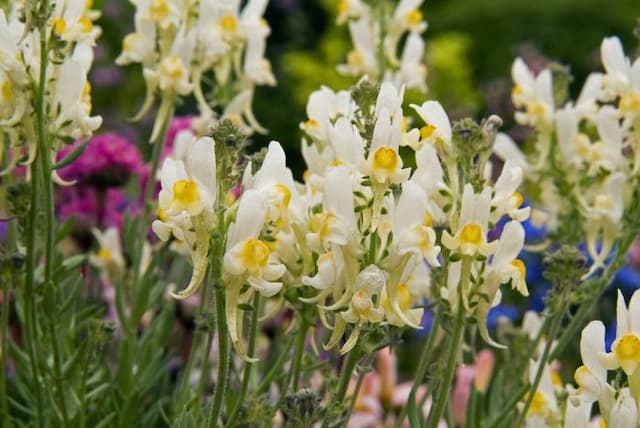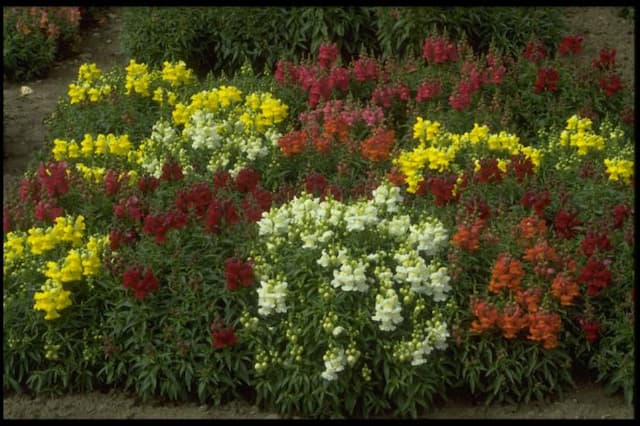Rock Penstemon Penstemon rupicola 'Diamond Lake'

ABOUT
The 'Diamond Lake' variety of Beardtongue is a striking perennial with a lush appearance. It boasts dense foliage that is notable for its broad leaves, which exhibit a silvery-blue color. This distinct hue gives the plant a cool, calming presence in garden spaces. During its blooming period, it produces an abundance of blossoms that stand out with their vibrant, rich purple hue. These trumpet-shaped flowers are assembled in clusters along the stems, offering a colorful display that is particularly attractive to pollinators such as bees and hummingbirds. The combination of the cool-toned leaves with the warm, inviting flowers creates a lovely contrast that adds depth and interest to any planting area where it is situated.
About this plant
 Names
NamesFamily
Plantaginaceae
Synonyms
Rock Penstemon, Cliff Beardtongue
Common names
Penstemon rupicola 'Diamond Lake'.
 Toxicity
ToxicityTo humans
The plant Penstemon rupicola 'Diamond Lake', commonly known as Beardtongue, is not known to be toxic to humans. There are no well-documented cases or significant research indicating that this plant poses a risk upon ingestion. As with many plants, individual sensitivities may vary, and it's always advisable to avoid ingesting parts of ornamental plants due to the potential for unexpected allergic reactions or gastrointestinal discomfort.
To pets
Beardtongue is not commonly listed as a toxic plant to pets. There is limited information regarding the toxicity of Penstemon rupicola 'Diamond Lake' to animals, but it is generally considered to be non-toxic. However, as pets can have varying reactions to plants, it's best to prevent pets from ingesting this or any ornamental plant to avoid the possibility of an upset stomach or an allergic reaction. If a pet does ingest Beardtongue and shows signs of distress, it is recommended to consult a veterinarian.
 Characteristics
CharacteristicsLife cycle
Perennials
Foliage type
Evergreen
Color of leaves
Green
Flower color
Purple
Height
1-2 feet (30-60 cm)
Spread
1-2 feet (30-60 cm)
Plant type
Herb
Hardiness zones
5
Native area
North America
Benefits
 General Benefits
General Benefits- Aesthetic Appeal: Adds vibrant color and texture to gardens with its striking blue-purple flowers and lush foliage.
- Wildlife Attraction: Attracts hummingbirds, bees, and butterflies, providing nectar and contributing to pollination.
- Drought Tolerance: Once established, it is drought-resistant, reducing the need for frequent watering.
- Erosion Control: Its root system can help stabilize slopes and areas prone to erosion.
- Low Maintenance: Requires minimal care once established, making it suitable for low-maintenance landscaping.
- Deer Resistance: Often resistant to deer browsing, which can be beneficial in areas with high deer populations.
- Adaptability: Adapts to a wide range of soils, although it prefers well-draining conditions.
- Seasonal Interest: Provides seasonal interest from late spring to early summer when in bloom.
- Edging and Borders: Compact growth habit makes it suitable for use as edging or in garden borders.
- Rock Gardens: Specially suited for rock gardens due to its ability to thrive in rocky, well-drained soils.
 Medical Properties
Medical PropertiesThis plant is not used for medical purposes.
 Air-purifying Qualities
Air-purifying QualitiesThis plant is not specifically known for air purifying qualities.
 Other Uses
Other Uses- Penstemon rupicola 'Diamond Lake', commonly known as Rock Penstemon, can be used as a dye source, with various parts of the plant providing natural pigments for textile coloring.
- The Rock Penstemon's sturdy stems can be used in dried floral arrangements, adding an interesting texture and variety to the composition.
- The leaves of the Rock Penstemon can be pressed and included in botanical art projects for their intricate shapes and patterns.
- The flowers of the plant can be utilized as garnishes for salads and desserts, provided they are free from any harmful pesticides.
- Rock Penstemon can be planted in rock crevices and walls to stabilize soil and reduce erosion in gardens.
- The plant's dense growing habit is used to create low, natural dividers in gardens and public parks.
- Rock Penstemon can be incorporated into a sensory garden because of its attractive flowers and textured foliage, which provide visual and tactile stimuli.
- The plant can be used as a natural indicator species in certain regions, where its health reflects the condition of its surrounding ecosystem.
- Rock Penstemon may be used in educational settings, like school gardens, to teach students about pollination and native plant species.
- The leaves and stems can be used in the creation of eco-friendly potpourri mixes for a subtle, natural scent in the home.
Interesting Facts
 Feng Shui
Feng ShuiThe Rock Penstemon is not used in Feng Shui practice.
 Zodiac Sign Compitability
Zodiac Sign CompitabilityThe Rock Penstemon is not used in astrology practice.
 Plant Symbolism
Plant Symbolism- Resilience: Penstemon rupicola 'Diamond Lake', commonly known as Rock Penstemon, often grows in rocky, challenging environments, representing the ability to thrive despite difficulties.
- Endurance: The Rock Penstemon's hardy nature symbolizes longevity and the strength to endure hardships over time.
- Charm and Attraction: With its striking blooms, the Rock Penstemon symbolizes the power of attraction and the beauty that can draw others in.
- Diversity: Rock Penstemon comes in various colors and forms, representing diversity and the richness that comes from a varied life experience.
 Water
WaterRock penstemon (Penstemon rupicola 'Diamond Lake') requires moderate watering to establish a deep root system, especially during its first growing season. After establishment, the plant is quite drought-tolerant and should only be watered deeply once every two weeks during prolonged dry spells. Provide about 1 gallon of water per plant for each watering session, ensuring that the soil is allowed to dry out between waterings to prevent root rot. Overhead watering is not recommended, as this can promote disease; instead, water directly at the base of the plant to keep the foliage dry.
 Light
LightRock penstemon prefers full sun to partial shade, thriving best in a location that receives at least 6 hours of direct sunlight per day. The ideal spot for these plants is in an area with bright, unfiltered sunlight for most of the day, though they can tolerate some light afternoon shade, especially in hotter climates.
 Temperature
TemperatureRock penstemon is hardy and can withstand temperatures as low as 10°F but performs best in areas where typical growing season temperatures range between 60°F and 75°F. They can tolerate summer highs up to around 85°F but may require additional watering during these warmer periods to prevent stress.
 Pruning
PruningPrune rock penstemon in the late winter or early spring to promote healthy growth and flowering. Remove dead or damaged stems and spent flower stems to encourage new growth and additional blooms. Pruning can be done annually, cutting back the plant by about one-third to maintain its shape and vigor.
 Cleaning
CleaningAs needed
 Soil
SoilRock Penstemon prefers well-draining, coarse, gritty soil with a pH of 6.0 to 8.0. A mix of sand, loam, and gravel with added compost is ideal to ensure proper drainage and fertility.
 Repotting
RepottingRock Penstemon does not require frequent repotting; it can be repotted every 2 to 3 years, or when you observe that the plant has outgrown its current container.
 Humidity & Misting
Humidity & MistingRock Penstemon thrives in low to moderate humidity conditions, typical of its native mountainous habitat, without the need for additional humidity adjustments.
 Suitable locations
Suitable locationsIndoor
Ensure bright light, minimal water, and cool temps.
Outdoor
Plant in full sun, well-drained soil, and water sparingly.
Hardiness zone
4-8 USDA
 Life cycle
Life cycleThe life of Penstemon rupicola 'Diamond Lake', commonly known as Rock Penstemon, begins as a seed which, when sown, germinates in favorable conditions of light and temperature, typically in the spring. The seedling emerges and develops true leaves, establishing itself as a juvenile plant. With ample sunlight, water, and soil nutrients, the Rock Penstemon grows into a mature plant, forming a foliage clump and eventually producing tall flowering spikes adorned with blue, purple, or pink tubular flowers favored by pollinators such as bees and hummingbirds. After pollination, which may be assisted by these visitors, the flowers fade and seed capsules form, containing numerous tiny seeds that mature and are eventually dispersed by wind or gravity. The adult plant may enter a period of dormancy during the winter months, especially in colder climates. With the return of warmer weather, the Rock Penstemon emerges from dormancy, ready to grow and bloom in a new season, thus completing its perennial life cycle.
 Propogation
PropogationPropogation time
Spring to Summer
Propogation: The Penstemon rupicola 'Diamond Lake', commonly known as Rock Penstemon, is best propagated during late winter to early spring, before new growth begins. The most popular method of propagation for Rock Penstemon is by taking stem cuttings. To do this, select a healthy stem and cut a segment about 4 to 6 inches (approximately 10 to 15 centimeters) long. The cut should be made just below a leaf node because this area contains cells that are essential for root development. Remove the lower leaves to expose the nodes, and dip the cut end into rooting hormone to encourage root growth. Next, plant the cutting in a pot filled with well-draining soil mix, ensuring that at least one or two nodes are buried where the roots will form. Water the cutting and place it in a bright spot out of direct sunlight while maintaining the soil moisture until roots have established and new growth is evident.



![Hebe [Garden Beauty Blue]](/_next/image?url=https%3A%2F%2Fplants-admin.emdemapps.com%2Fimages%2Fplants%2F%2Fimages%2F604b58cbcb4e2.png&w=640&q=75)



![Foxglove [Illumination Ruby Slippers]](/_next/image?url=https%3A%2F%2Fplants-admin.emdemapps.com%2Fimages%2Fplants%2F%2Fimages%2F604b5cbc93f0b.png&w=640&q=75)
![Hebe [Garden Beauty Purple]](/_next/image?url=https%3A%2F%2Fplants-admin.emdemapps.com%2Fimages%2Fplants%2F%2Fimages%2F604b646a3d922.png&w=640&q=75)